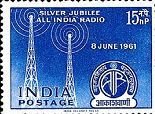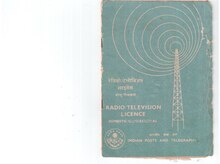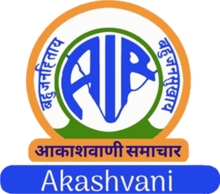|
All India Radio
All India Radio (AIR), also known as Akashvani (lit. 'Voice from the sky' or 'Oracle'), is India's state-owned public radio broadcaster. Founded in 1936,[2] it operates under the Ministry of Information and Broadcasting and is one of the two divisions of Prasar Bharati.[3] Headquartered at the Akashvani Bhavan in New Delhi, it houses the Drama Section, FM Section, and National Service. It also serves as the home of the Indian television station Doordarshan Kendra. All India Radio is the largest radio network in the world in terms of the number of languages broadcast, the socioeconomic diversity it serves, and the scale of its broadcasting organisation. AIR's domestic service includes 420 stations nationwide, covering nearly 92% of India's geographic area and 99.19% of its population, with programming available in 23 languages and 179 dialects.[4]  HistoryAkashvaniWhen the Indian State Broadcasting Service (ISBS) was renamed to All India Radio, Rabindranath Tagore rechristened it Akashvani, the voice that comes over from the skies, in a poem penned for the inauguration of Kolkata's shortwave service.[5][6] The term Akashvani was also used in the context of radio by M. V. Gopalaswami in 1936 when he established India’s first private radio station at his residence, "Vittal Vihar," located about 200 yards from the current All India Radio station in Mysore.[7] In 1956, Akashvani was adopted as All India Radio's on-air name. With its literal meaning in Sanskrit as "voice from the sky," the name was considered highly fitting for a broadcaster. The suggestion to use Akashvani came from the poet Pandit Narendra Sharma. During the British RajBroadcasting commenced in June 1923 during the British Raj with programmes by the Bombay Presidency Radio Club and other radio clubs. According to an agreement on 23 July 1927, the private Indian Broadcasting Company Ltd (IBC) was authorised to operate two radio stations: the Mumbai station, which began on 23 July 1927, and the Kolkata station, which followed suit on 26 August 1927. The organisation went into liquidation on 1 March 1930. The government took over broadcasting facilities and launched the Indian State Broadcasting Service (ISBS) on April 1, 1930, initially on an experimental basis for two years. It became a permanent service in May 1932 and was later renamed All India Radio on June 8, 1936.[2] The building was contracted by Sir Sobha Singh.[8]   On 1 October 1939, the External Service began with a broadcast in Pashto. It was intended to counter radio propaganda from Germany directed at Afghanistan, Iran, and Arab nations. The Dhaka station in Eastern India, in what is now Bangladesh, opened in 1939. This station catered to and nurtured the pioneers of Bengali intellectuals. The foremost among them, Natyaguru Nurul Momen, became the trailblazer of the talk show in 1939. He wrote and directed the first modern radio play for this station in 1942.[citation needed] In December 1940, the Standing Finance Committee sanctioned a sum of Rupees 9,30,000 for the establishment of a new headquarters of the All India Radio in Delhi.[9] The new “Broadcasting House” of AIR at Parliament Street in New Delhi was inaugurated in February 1943. [10] In 1956, All India Radio (AIR) was officially renamed Akashvani, and its headquarters were renamed Akashvani Bhawan.[11] After IndependenceWhen India became independent in 1947, the All India Radio network consisted of only six stations: Delhi, Bombay, Calcutta, Madras, Lucknow, and Tiruchirappalli. The three radio stations in Lahore, Peshawar, and Dhaka remained in what eventually became Pakistan after the partition. At that time, there were approximately 250,000 radio sets in India.[12] In August 1947, All India Radio hired its first female newsreader, Saeeda Bano, who read the news in Urdu.[13] On October 3, 1957, the Vividh Bharati service was launched by All India Radio to compete with Radio Ceylon. Television broadcasting commenced in Delhi in 1959 under the aegis of AIR, but was split off from the radio network as Doordarshan on 1 April 1976.[14] FM broadcasting began on 23 July 1977 in Chennai, and expanded during the 1990s.[15] Deccan Radio (Nizam Radio 1932), the first radio station in the princely Hyderabad State (now Hyderabad), went live on 3 February 1935. It was launched by Mir Osman Ali Khan, the seventh Nizam of Hyderabad, boasting of a transmitting power of 200 Watts. On 1 April 1950, after Operation Polo, Deccan Radio was taken over by the Indian Government, and in 1956, it was merged with All India Radio. Thereafter, it has been known as AIR-Hyderabad (100 kW).[16]  Domestic servicesAIR offers a variety of services in multiple languages, each catering to different regions across India. Vividh BharatiVividh Bharati, launched in 1957, is one of the most well-known services of All India Radio. Its name roughly translates to "Diverse Indian" and is also referred to as the Commercial Broadcasting Service (CBS). Commercially, it is the most accessible AIR network, particularly popular in Mumbai and other large cities. Vividh Bharati offers a wide range of programs, including news, film music, short plays, music, and comedy. It operates on various mediumwave and FM frequencies in each city. Some programmes broadcast on Vividh Bharati are:
Central Sales UnitThe Central Sales Unit (CSU), located in Mumbai, handles the commercial affairs of AIR. [17] Other servicesRegional servicesThe headquarters of the Regional Deputy Directors General are located in Delhi and Chandigarh (NR), Lucknow and Bhopal (CR), Guwahati (NER), Kolkata (ER), Mumbai and Ahmedabad (WR), and Chennai and Bangalore (SR)[20] All frequencies are in kHz, unless otherwise specified. Most of the channels are also available online.
External services
The external services of All India Radio are broadcast in 27 languages to countries outside India via high-power shortwave radio transmissions. Mediumwave is also used to reach neighboring countries. In addition to language-specific broadcasts targeted at particular countries, there is a General Overseas Service that broadcasts in English, offering 8¼ hours of programming daily aimed at a general international audience. The external broadcasts began on October 1, 1939, initiated by the British government to counter Nazi propaganda directed at the Afghan people. Initially, the broadcasts were in Pashto, targeting Afghanistan and the North-West Frontier Province. Over time, broadcasts expanded to include languages such as Dari, Persian, Arabic, English, Burmese, Japanese, Chinese, Malay, and French. Currently, the external services broadcast in 16 foreign languages and 11 Indian languages, with a total program output of 70¼ hours per day on medium and shortwave frequencies.
Two high-powered FM stations of All India Radio are being installed in Amritsar and Fazilka, Punjab, to complement the programs broadcast from transmitters in Jalandhar, New Delhi, Chandigarh, and Mumbai. These stations aim to improve broadcast services, particularly during unfavorable weather conditions, in the border regions of Punjab. Today, the External Services Division of All India Radio broadcasts 57 transmissions daily, offering nearly 72 hours of programming that reaches over 108 countries in 27 languages. Of these, 15 are foreign languages and 12 are Indian. The foreign languages include Arabic, Baluchi, Burmese, Chinese, Dari, French, Indonesian, Persian, Pushtu, Russian, Sinhala, Swahili, Thai, Tibetan, and English (General Overseas Service). The Indian languages are Bengali, Gujarati, Marathi, Konkani, Kashmiri, Hindi, Kannada, Malayalam, Nepali, Punjabi, Saraiki, Sindhi, Tamil, Telugu, and Urdu. The longest daily broadcast is the Urdu Service to Pakistan, which airs around the clock on DTH (direct-broadcast satellite) and on short- and medium-wave for 12¼ hours. The English-language General Overseas Service is broadcast for 8¼ hours daily. During Hajj, special broadcasts in Urdu are beamed to Saudi Arabia. Additionally, AIR is planning to produce programs in the Balochi language.[22] The external services of All India Radio (AIR) are also broadcast to Europe in DRM (Digital Radio Mondiale) on 9950 kHz between 17:45 and 22:30 UTC. These transmissions are delivered via high-power transmitters located in Aligarh, Bengaluru, Chennai, Delhi, Gorakhpur, Guwahati, Mumbai, and Panaji on shortwave, and from Jalandhar, Kolkata, Nagpur, Rajkot, and Tuticorin on mediumwave. All India Radio Amritsar plans to launch a booster service on the FM band. Some of these transmitters have a power output of 1000 kW (1 MW) or 500 kW. Programs are broadcast to various parts of the world, excluding the Americas, with very good reception quality in the target areas. Each language service includes news, commentary, press reviews, talks on general or cultural topics, feature programs, documentaries, and music from India and the target region. Most of these programs originate from New Broadcasting House on Parliament Street in New Delhi, with some originating from SPT Bengaluru, Chennai, Hyderabad, Jalandhar, Kolkata, HPT Malad Mumbai, Thiruvananthapuram, and Tuticorin. The External Services Division of All India Radio (AIR) serves as a vital link between India and the rest of the world, particularly in countries with significant Indian diaspora. It broadcasts India's perspective on national and international matters and showcases the Indian way of life through its programs. QSL cards, which are highly sought after by international radio hobbyists, are issued by AIR in New Delhi in response to reception reports of their broadcasts. Direct-To-HomeDirect-to-home (DTH) service is a satellite broadcast service where a large number of radio channels are digitally transmitted over a territory from a high-power satellite. All India Radio broadcasts various national and regional stations, which can be accessed on DD Free Dish. The DTH signals can be received directly at homes using a small dish receiver unit, which includes a dish antenna installed on the rooftop or a wall facing clear south, with the receiver placed indoors.[23] DTH service is offered on twenty one channels via Insat. List of DTH channelsNational
Regional
Online services
Other servicesDigital Radio MondialeDetails of the Digital Radio Mondiale (DRM) transmissions and frequencies are as follows:
News-on-phoneAll India Radio launched its news-on-phone service on February 25, 1998, in New Delhi. The service is now available in Chennai, Mumbai, Hyderabad, Indore, Patna, and Bangalore. It can be accessed through subscriber trunk dialing (STD), international direct dialing (ISD), and local calls. Plans are in place to expand the service to 11 additional cities, including Ahmedabad, Bhopal, Guwahati, Gwalior, Jabalpur, Jaipur, Kolkata, Lucknow, Ranchi, and Shimla. The service allows users to listen to live hourly news bulletins in English and Hindi.[24] News in MP3 format can be directly played from the site, with filenames time-stamped for easy reference. All India Radio's news bulletins are available in nine regional languages: Tamil, Kannada, Gujarati, Bengali, Marathi, North East languages, Punjabi, Telugu, and Urdu. DocumentariesAll India Radio (AIR) has a long tradition of broadcasting documentary features, which have garnered significant interest, particularly in countries like India, Iran, South Korea, and Malaysia. The most prominent broadcaster of English features was Melville de Mellow, while Shiv Sagar Mishra was renowned for his Hindi features. This format has been revived by AIR producers across India due to its flexibility, relatively low production cost, messaging potential, and creative possibilities. Central Drama UnitAll India Radio's Central Drama Unit (CDU) is responsible for the national broadcast of plays. The plays produced by the CDU are translated and produced by regional stations. Since its inception in the 1960s, the unit has produced over 1,500 plays and maintains a repository of old scripts and productions. The National Programme of Plays, aired by the CDU, is broadcast on the fourth Thursday of each month at 9:30 pm. Each play in this program is produced in 22 Indian languages and broadcast simultaneously by all regional and national network stations. Additionally, the CDU produces Chain Plays, which are half-hour dramas broadcast in succession by a network of stations. Social Media CellThe News Service Division's Social Media Cell was established on May 20, 2013, and is responsible for delivering AIR news across new media platforms, including websites, Twitter, Facebook, and SMS. Gallery
See also
References
External linksWikimedia Commons has media related to All India Radio. Look up akashvani in Wiktionary, the free dictionary. |
|||||||||||||||||||||||||||||||||||||||||||||||||||||||||||||||||||||||||||||||||||||||||||||||||||||||||||||||||||||||||||||||||||||||||||||||||||||||||||||||||||||||||||||||||||||||||||||||||||||||||||||||||||||||||||||||||||||||||||||||||||||||||||||||||||||||||||||||||||||||||||||||||||||||||||||||||||||||||||||||||||||||||||||||||||||||||||||||||||||||||||||



